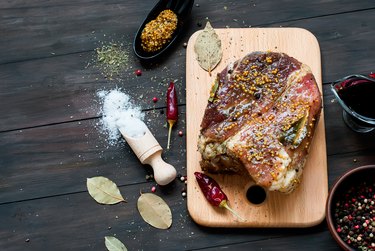
The great thing about thin chuck steak recipes is that you can prepare them in a variety of ways. Because the cut is thin, the steak cooks faster, so you can get a nice meal on the table in no time.
What is a Chuck Steak?
Video of the Day
According to Texas A&M University, chuck cuts come from the front shoulder area of a cow. Because it's a large muscle that has to do a lot of work, it is flavorful. However, the more worked a muscle area is, the tougher the resulting meat has a tendency to be.
Video of the Day
There are several chuck steaks to choose from, per the University of Nebraska, though not all beef chuck shoulder steak is thin. Options include:
- Top blade steak, also known as flat iron
- Boneless chuck eye roast
- Boneless arm pot roast
- Arm pot roast, also known as chuck arm roast
- Chuck eye roast, also known as mock tender roast
- Chuck eye steak, also known as mock tender steak
- Chuck roast center cut also known as a seven-bone pot roast
- Blade roast
Most chuck steak cut is best prepared with a moist cooking method such as cooking in liquid (boiling, simmering, steaming, etc.) or braising, to help tenderize the meat.
The boneless chuck eye roast can be prepared with either a moist or a dry cooking method. The top blade steak, however, is recommended for dry cooking methods only. These include grilling, roasting, baking, broiling, sautéing or searing.
Thin Chuck Steak Recipes
You'll find a number of thin chuck steak recipes out there. You can grill, bake, sear or broil the steaks, depending on what your chosen recipe calls for. Many easy chuck tender steak recipes call for it to be grilled. If you don't have a grill available, you can cook it in a pan on the stove or in the oven.
Regardless of your chosen cooking method, the U.S. Department of Health and Human Services says the meat, whether pork or beef, is safe to eat once it has reached an internal temperature of 145 degrees Fahrenheit (medium rare) and has three minutes of rest time.
Texas A&M says if you like your steak cooked medium, cook it until it reaches an internal temperature of 160 degrees F, and if you like it well done, cook it to an internal temperature of 170 degrees F.
Since your beef chuck shoulder steak is thin, you'll require hotter temperatures to cook it through. If you're dealing with steaks that are 1/2 inch thick, heat your grill to a surface temperature of about 425 to 450 degrees F. Coals should be medium-hot and barely covered with ash.
For steaks that are 3/4 inch to 1 inch thick, heat to 360 to 400 degrees F. Coals should be medium and have a light layer of ash.
Season your steaks to taste, and cook for two to three minutes per side for rare steak, four minutes on each side for medium steak and five to six minutes per side for well done, turning the steak only once to keep it from drying out.
To tenderize the meat ahead of cooking, place it in a marinade with your choice of flavorings for two hours to overnight prior to grilling.
Read more: 5 Tips for Eating Protein the Right Way
Is Chuck Steak Healthy?
Chuck steak nutrition depends on how it is prepared, what it is prepared with and the portion size. Easy chuck tender recipes made with butter will be higher in calories and fat than those made with just basic seasonings. Beef chuck shoulder steak that is thin still has the same nutrition as one that is thick because it's about the overall portion size.
The USDA shows that a 4-ounce serving of beef chuck eye steak trimmed to 0 inches fat contains 257 calories, 21 grams of protein and 19 grams of fat. Many other cuts of beef offer a leaner source of protein.
The American Heart Association cautions against eating too much red meat because of the saturated fat content. Though you can safely include it in your diet, it is best to opt for lean cuts and eat more chicken and fish.
- Texas A&M University: "How to Transform Cheap Chuck Steak and Roast Into a Great Meal"
- University of Nebraska: "Chuck: Beef Meat Identification"
- U.S. Department of Health and Human Services: "Safe Minimum Cooking Temperatures Charts"
- Texas A&M University Agrilife Extension: "All About Beef"
- U.S. Department of Agriculture FoodData Central: "Beef, Chuck Eye Steak, Boneless, Separable Lean and Fat, Trimmed to 0'' Fat, Choice, Raw"
- American Heart Association: Meat, Poultry and Fish: "Picking Healthy Proteins"